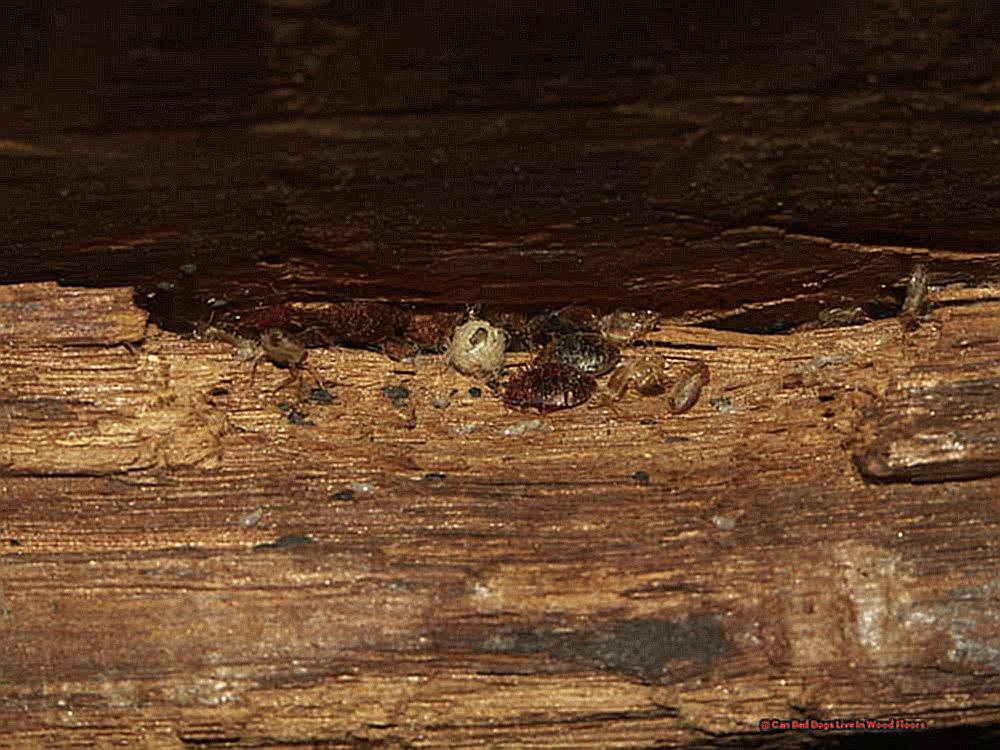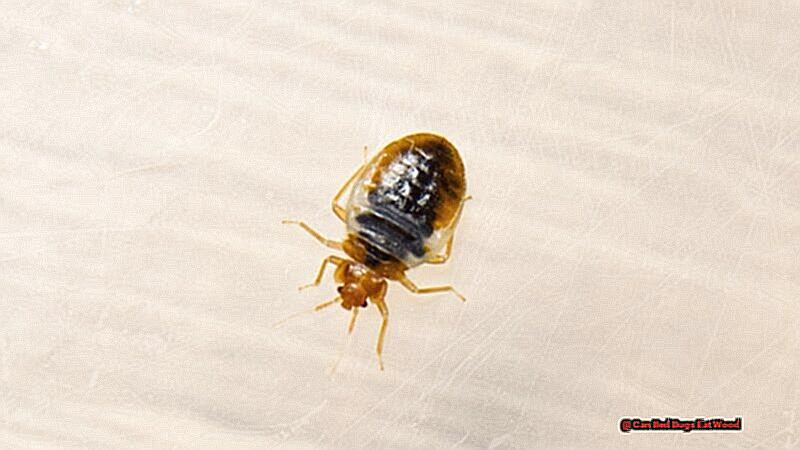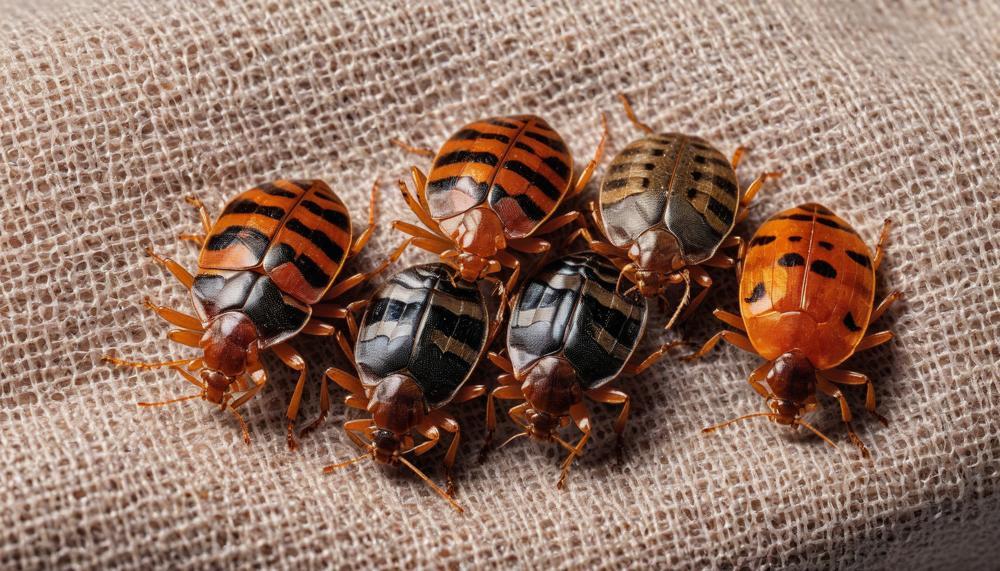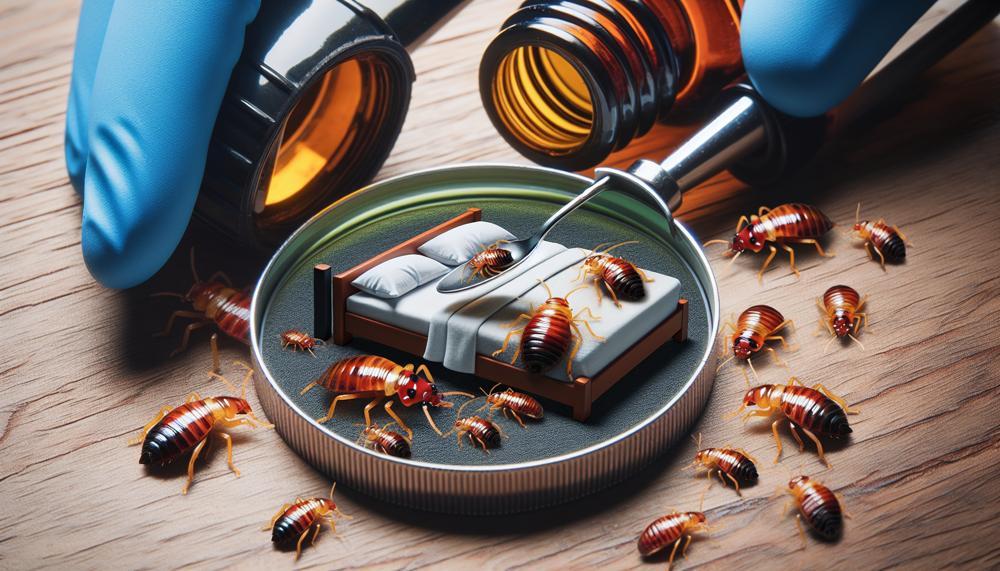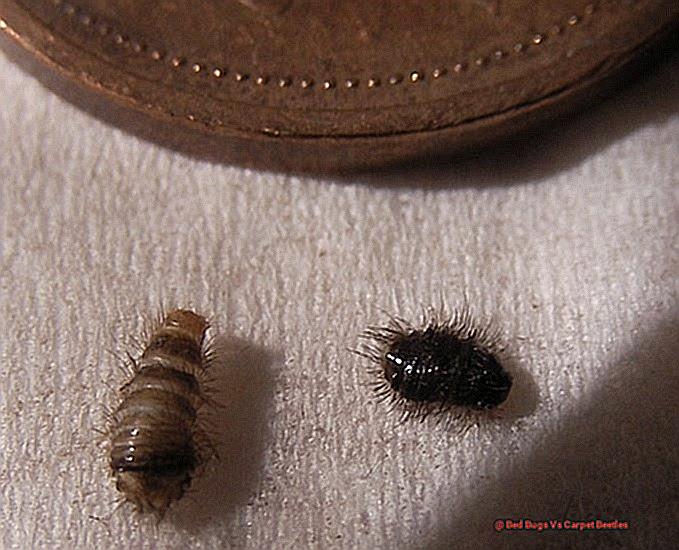Welcome to our latest blog post, where we’ll be delving into the intriguing world of bed bugs and their remarkable survival abilities.
You may have heard tales of these pesky insects infesting your mattress or lurking in the crevices of your walls, but did you know that they can also thrive in wood floors? Yes, these minuscule creatures possess a unique adaptability that allows them to flourish in unexpected places.
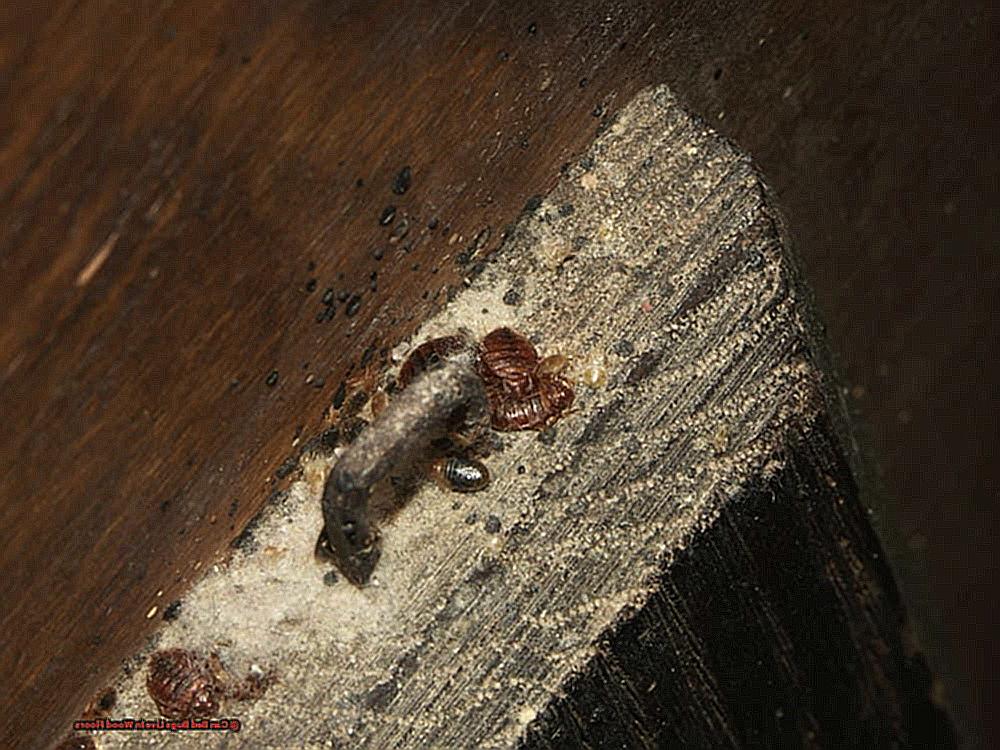
But how exactly do they accomplish this feat? And what implications does it have for homeowners and renters alike?
So sit back, relax, and join us on a journey through the captivating realm of bed bugs and their ability to survive within wood floors.
Table of Contents
- 1 Can Bed Bugs Live On Wooden Floor?
- 2 Why Are Bed Bugs Attracted To Wooden Floor?
- 3 Can Bed Bugs Poop On Wooden Floor?
- 4 Bed Bugs Eggs On Wooden Floor?
- 5 How To Get Rid Of Bed Bugs On Hardwood Wood Floors?
- 6 Do Bed Bugs Live On Tiles Floor?
- 7 Can Bed Bugs Crawl On Tile Floor?
- 8 How To Rid Of Bed Bugs Form Tile Floor?
- 9 Can Bed Bugs Infest Carpet Finished Floor?
- 10 How Do Bed Bugs Get Into Your Carpet Floor?
- 11 How To Find Bed Bugs On Carpet Floor?
- 12 Conclusion
Can Bed Bugs Live On Wooden Floor?
However, the truth is that bed bugs are attracted to warmth, carbon dioxide, and human skin, making wooden floors a possible target for their infestation. In this informative piece, we will explore the perplexing reality of bed bugs on wooden floors and provide actionable solutions for their eradication.
How Do Bed Bugs Invade Wooden Floors?
The deceptive nature of bed bugs allows them to sneak into unsuspecting homes through various means. Their affinity for warmth and hiding spots makes cracks and crevices in wooden floors an ideal shelter for these tiny creatures. This means that even if you have taken precautions and kept your mattress bed bug-free, your wooden floors may still harbor these pests.
Detecting Bed Bug Infestations on Wooden Floors
Identifying a bed bug infestation on your wooden floor can be challenging, but not impossible. Keep an eye out for any cracks or gaps in the flooring, droppings, shed skins, visible bugs crawling around, or a musty odor from their pheromones. Additionally, if you find yourself with unexplained itchy red bumps on your skin, it could be due to bed bug bites.
Preventing Bed Bugs on Wooden Floors
As the saying goes, prevention is better than cure. To keep bed bugs at bay from your wooden floors, it is crucial to take precautionary measures. These hitchhikers can easily make their way into your home through travel or second-hand items.
Therefore, it is essential to regularly mop your wooden floors with hot water and use natural cleaners like diatomaceous earth or essential oils.
Additionally, sealing all holes and cracks in the flooring can prevent bed bugs from finding hiding spots.
Why Are Bed Bugs Attracted To Wooden Floor?
Are you experiencing unexplainable bites on your skin and unusual brown marks on your wooden floors? If so, you may have a bed bug infestation. These minuscule creatures not only cause annoyance but also pose health risks. And when it comes to wooden floors, they are a perfect hiding spot for bed bugs.
But what exactly makes bed bugs gravitate towards wooden floors? Let’s delve into the various types of finishes for hardwood floors and discover how they can ward off these pesky pests.
Polyurethane Finish: The Most Common Choice
The majority of hardwood floors have a polyurethane finish, which provides a protective coat and adds luster to the wood. There are two kinds of polyurethane finishes – oil-based and water-based. While both offer durability, water-based is more environmentally friendly and dries faster. However, oil-based polyurethane typically enriches the color of the wood.
To apply these finishes, diligently adhere to the manufacturer’s instructions. Ensure proper ventilation in the room and take necessary precautions while handling these chemicals. Both types of finishes create a robust barrier against bed bugs, preventing them from seeking refuge in the wood.
Shellac, Lacquer, and Varnish: Special Care Required
Shellac, lacquer, and varnish are other options for finishing hardwood floors. However, they require specific treatment and should not be mixed with polyurethane. These finishes tend to wear off quicker than polyurethane, making them less effective in keeping bed bugs at bay.
Wax: A Popular Yet Tricky Alternative
Wax is a favored finish for hardwood floors as it imparts a warm and natural appearance to the wood. However, it demands regular upkeep and can be challenging when it comes to deterring bed bugs.
Can Bed Bugs Poop On Wooden Floor?
Bed bugs are a regular household nuisance that can cause a great deal of discomfort and frustration. These minuscule insects thrive on human blood and can quickly infest a home if not properly addressed.
While they are commonly associated with bedding and furniture, the question arises – can bed bugs also take up residence on hardwood flooring? The answer may surprise you – yes, they can.
Indications of Bed Bug Infestation on Hardwood Floors
If you have hardwood floors in your home, it’s crucial to be aware of the signs of a potential bed bug infestation. These include:
- Dark spots: Bed bugs leave behind dark spots of excrement near their hiding places. These spots may appear on your hardwood floors and can easily be mistaken for dirt or regular stains.
- Shed skins: As bed bugs mature, they shed their skin multiple times. These cast-off skins may be visible on your hardwood floors, especially near their hiding spots.
- Visible bugs: In severe infestations, you may actually see live bed bugs crawling around on your hardwood floors. Due to their small and flat bodies, they can easily hide in cracks and crevices.
- Musty odor: Bed bugs release pheromones that emit a musty odor. If your hardwood floors have an unusual smell, it could be an indication of a bed bug infestation.
Bed Bugs Eggs On Wooden Floor?
Let us first delve into the intricacies of bed bugs. These minuscule insects are drawn to warmth, carbon dioxide, and human skin, making them prevalent not only in bedding and mattresses but also on wooden floors. They can easily be brought into your home through travel or second-hand furniture, quickly reproducing and causing severe infestations if left untreated.
Identifying bed bug bites is crucial as they can cause itchy red bumps and even allergic reactions. Contrary to popular belief, bed bugs can infest hardwood floors due to their affinity for warmth, carbon dioxide, and the scent of human skin.
Prevention is key when it comes to dealing with bed bugs. Regular maintenance such as mopping with hot water and sealing all cracks in wooden floors can aid in keeping these creatures at bay. However, it is essential to note that certain types of hardwood floors may attract bed bugs more than others. In such cases, replacing old wood that may not survive aggressive treatments should be considered.
One effective prevention method is to seal hardwood floors with sealers. This prevents bed bugs from entering cracks where they often hide and lay their eggs.
If bed bugs have already made themselves at home on your wooden floors, fear not. There are several treatment options available. Heat treatment has proven to be the most successful method in eliminating these pests. However, it can be costly and time-consuming. For a less invasive approach, natural remedies such as diatomaceous earth, essential oils, and vinegar solutions can also be used.
Regularly maintaining your floors and keeping a tidy home can also deter bed bugs from making themselves comfortable in your space.
In conclusion, do not let the presence of bed bug eggs on your wooden floor cause you distress.
How To Get Rid Of Bed Bugs On Hardwood Wood Floors?
Bed bugs, a prevalent household pest, can be found not only in mattresses but also on hardwood floors. These pesky creatures are attracted to warmth, carbon dioxide, and human skin, making your wood floors a desirable location for them to thrive. If you’re facing a bed bug infestation on your hardwood floors, you may be wondering – what are some proven techniques for eradicating these pests?
Regularly vacuuming your hardwood floors is a crucial step in preventing bed bugs from taking up residence. This will help eliminate any eggs, nymphs, or adults that may be lurking in the crevices and cracks of your wood flooring. Additionally, using bed bug-proof mattress and box spring covers will deter these pests from migrating onto your floors.
Another effective method for eliminating bed bugs on hardwood floors is steam cleaning. The high temperature of the steam will obliterate any bed bugs hiding in the nooks and crannies. For added protection, you can also mix hot water with essential oils and apply it to your wood floors to cleanse and repel pests.
Utilizing natural cleaners such as diatomaceous earth, wood polish oils, and essential oils can also aid in getting rid of bed bugs on hardwood floors. These natural remedies are safe for both humans and pets, making them an excellent alternative to harsh pesticides.
It’s crucial to note that prevention is key in keeping your home free of bed bugs. Regularly mopping with hot water and using natural cleaners can help discourage bed bugs from infesting your hardwood floors. It’s also vital to seal any cracks or gaps in your flooring to prevent bed bugs from hiding and multiplying.
In more severe cases, heat treatment may be necessary to completely eradicate bed bugs on wood floors. This involves using specialized equipment to raise the temperature in a room to a level that is lethal for bed bugs.
In conclusion, eliminating bed bugs on hardwood floors requires a combination of preventative measures and effective treatments.
Do Bed Bugs Live On Tiles Floor?
While the answer may seem straightforward, there are certain factors that make it more complex. Yes, bed bugs can indeed live on tile floors, but the chances of them choosing your tiles as their new home are quite slim. Let’s delve into the intricacies that make tile floors attractive to bed bugs and explore effective methods to keep them at bay.
Factors That Make Tile Floors Appealing to Bed Bugs
Although tile flooring may not be the top choice for these blood-sucking insects, there are several elements that can make it an enticing option:
Cracks and Crevices
Similar to hardwood floors, tile floors also have cracks and holes that provide ample hiding spots for bed bugs. These tiny crevices make it challenging for homeowners to detect and eliminate bed bugs, as they can easily camouflage themselves within the tiles.
Smooth Movement
The bumps and grooves present in tiles allow bed bugs to move around with ease. While the grooves may slow down their progress, they are not enough to completely hinder them. This enables bed bugs to travel freely from room to room, increasing the risk of infestation throughout your home.
Moisture
One of the primary reasons why bathrooms are a favorite spot for bed bugs is moisture. Since most bathrooms have tile flooring, it becomes an ideal environment for these pests to thrive. The humidity from showers and baths creates optimal breeding conditions for bed bugs, allowing them to reproduce rapidly.
How to Deter Bed Bugs from Your Tile Floors
Now that we understand why bed bugs may find tile floors appealing, let’s explore some effective measures to keep them away:
Seal Cracks and Crevices
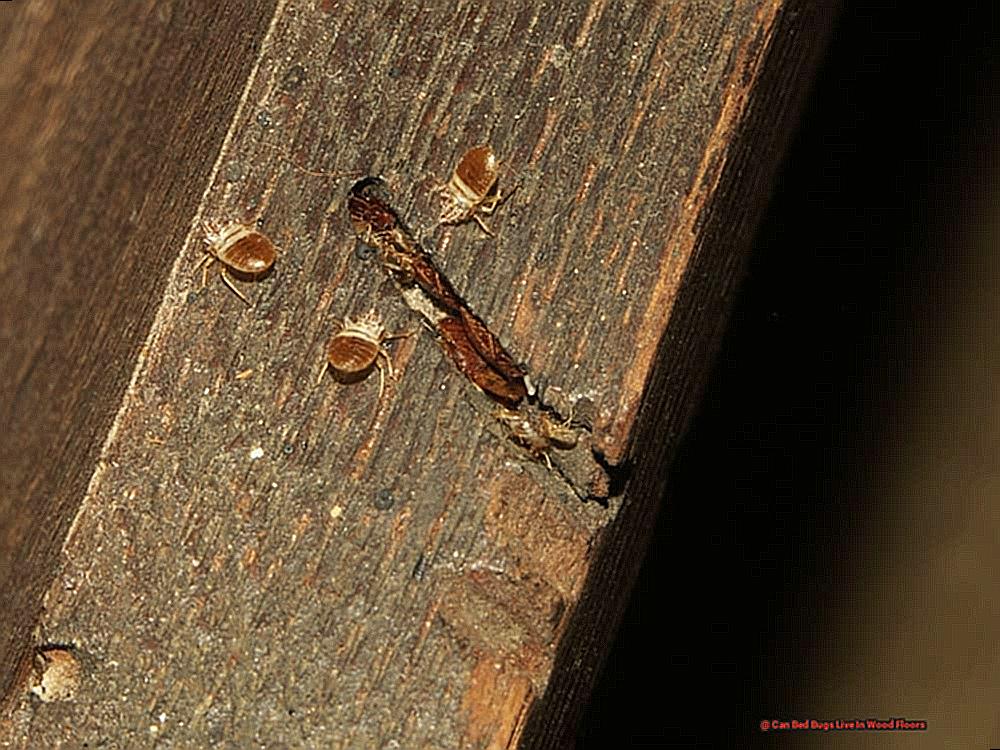
Regularly inspect your tile flooring for any cracks or crevices and seal them promptly with a strong adhesive or caulk.
Can Bed Bugs Crawl On Tile Floor?
The notorious bed bug is a master of hiding and thriving in various environments, from cozy beds to sturdy furniture. But what about tile floors? Can these pesky pests crawl on such a smooth surface? The answer is yes, my dear reader. While they may prefer wood flooring for its numerous hiding places and suitable surface for laying eggs, bed bugs can also make themselves at home on tile floors if given the opportunity.
But do not fear, for there are effective methods to eliminate these unwelcome invaders from your tile floors and prevent future infestations. As an expert on bed bugs, I have delved into the research and compiled the best tactics for getting rid of these bothersome bugs on tile floors.
Vacuuming:
The most effective method for eliminating bed bugs on tile floors is none other than vacuuming. Use a vacuum with strong suction to thoroughly clean every nook and cranny of the floor, including corners and edges. Pay close attention to cracks and gaps where bed bugs may be lurking. After use, make sure to empty the vacuum immediately and dispose of the contents in a sealed plastic bag.
Alcohol-based sprays:
Another potent tool in the battle against bed bugs on tile floors is alcohol-based sprays. These sprays are known to kill bed bugs on contact and can be directly applied to infested areas on the floor. Be cautious when handling chemicals and follow the instructions carefully for optimal results.
Seal cracks and gaps:
To prevent re-infestation, it is crucial to seal any cracks or gaps in the tile floor after cleaning. Bed bugs can easily hide in these spaces, making it challenging to fully eradicate them. Using caulk or sealant, fill in any gaps or cracks in the floor to create a barrier against these persistent pests.
Steam cleaning:
For carpeted areas near tile floors, steam cleaning can be a game-changing method for getting rid of bed bugs without damaging the fabric.
How To Rid Of Bed Bugs Form Tile Floor?
These elusive insects are notorious for their ability to evade eradication, causing immense stress and discomfort. But fear not, as there are effective techniques for eliminating bed bugs on tile floors.
Eliminate the Clutter
The initial step in getting rid of bed bugs on tile floors is to eradicate any clutter. These pesky creatures thrive in the cracks and crevices found in cluttered spaces, so it is crucial to remove any potential hiding spots. This includes books, magazines, garments, and any other objects that may be strewn about or lurking under your bed.
Seal Up Openings
Next, it is vital to seal up any openings where bed bugs can enter or take refuge. This entails securing loose wallpaper with glue, caulking cracks in furniture and along baseboards, and covering open electrical outlets with tape.
Blast with High Heat
Bed bugs cannot withstand extreme temperatures, making washing your clothes and bed linens with high heat a powerful method for extermination. Be sure to utilize the hottest settings on both your washer and dryer to guarantee the complete elimination of all bed bugs.
Regularly Vacuum
Vacuuming is yet another efficient technique for getting rid of bed bugs on tile floors. Use a vacuum with strong suction power and ensure to empty the bag or canister outside immediately after use.
Attempt Extreme Temperatures
In severe infestations, it may be necessary to utilize extreme temperatures to rid yourself of bed bugs. This involves subjecting infested items to intense heat or cold for a designated period, effectively killing off both the bugs and their eggs.
Steam Cleanse
Another effective method for eliminating bed bugs on tile floors is steam cleaning. The high temperature of steam kills bed bugs upon contact and can penetrate deep into crevices where they may be hiding.
Can Bed Bugs Infest Carpet Finished Floor?
While we all want to believe that our homes are impervious to pests, the reality is that these tiny insects can find their way into even the most well-maintained living spaces. So, can bed bugs infest carpet finished floors? The answer may surprise you.
Bed bugs, with their small size and ability to hide in various materials, have become a notorious headache for homeowners. And while they are commonly associated with bedding and furniture, they can also infest carpeted areas. This is due to their preference for soft materials and the warmth and coziness that carpets provide.
There is a solution that can prevent bed bugs from infesting your carpet finished floor – filling in gaps and cracks on your wooden floor. This method has proven to be effective in keeping bed bugs at bay, and here’s why:
Eliminates Hiding Spots
Bed bugs are masters of concealment and can squeeze into even the tiniest of spaces. By filling in gaps and cracks on your wooden floor, you eliminate potential hiding spots for these pests, making it difficult for them to access your carpeted areas.
Prevents Migration
Bed bugs can easily migrate from one area to another, especially if there are gaps and cracks in the flooring. Filling in these openings creates a barrier, preventing the spread of bed bugs and containing them to one area.
So, if you’re worried about bed bugs infesting your carpet finished floor, consider filling in any gaps and cracks on your wooden floor as a preventive measure. Not only will this help keep your home free from these pesky pests, but it will also protect your beautiful carpet for years to come.
How Do Bed Bugs Get Into Your Carpet Floor?
Bed bugs are minuscule, elusive creatures that can invade your home without warning. Despite modern technology and pest control methods, these blood-sucking pests have been a nuisance for centuries and continue to thrive. They are most active at night, making it challenging to detect their presence until it’s too late.
So, how do bed bugs get into your carpet floor? Their small size and ability to hide in tiny spaces are the key. These pests can easily hitch a ride on clothing, luggage, and even pets. They can also crawl through cracks and crevices in walls, floors, and furniture. Once inside your home, they quickly spread throughout the house, including your carpets.
Effective Ways to Prevent Bed Bugs from Getting into Your Carpet:
Reduce Clutter on Your Carpet:
One of the simplest ways to prevent bed bugs from infesting your carpets is by reducing clutter. A cluttered carpet offers numerous hiding spots for bed bugs to lay their eggs and hide during the day. Regularly vacuuming and decluttering your carpet will eliminate potential hiding spots for these pests.
Regularly Clean Your Carpet:
Regularly cleaning your carpet is crucial in preventing bed bugs from infesting it. Vacuuming at least once a week can help remove any bed bugs or eggs that may be hiding in the carpet fibers. Steam cleaning your carpet is also an effective way to kill any bed bugs that may be present.
Apply Pesticides:
Applying a pesticide along the walls and edges of your carpet forms a barrier that prevents bed bugs from crawling onto your carpet. Be sure to use a pesticide specifically designed for bed bugs and follow the instructions carefully.
Seal Cracks and Crevices:
Bed bugs can easily crawl through cracks and crevices in walls and floors, so it’s essential to seal them off.
How To Find Bed Bugs On Carpet Floor?
These minuscule, bloodthirsty insects can cause itchy bites, allergies, and even psychological turmoil. While they are often associated with mattresses, it’s essential to know that bed bugs can also be found lurking on your carpet floor. In this post, we will delve into effective techniques for detecting and eliminating these pesky pests from your carpet.
Illuminate with a Beam of Light
The first step in uncovering bed bugs on your carpet floor is a meticulous inspection. Utilize a flashlight to shine light along the edges of your carpet, around baseboards, and in dimly lit corners. As nocturnal creatures, bed bugs typically hide in these areas during the day.
Look Out for Telltale Signs
Bed bugs leave behind several clues that can help you identify an infestation. Keep an eye out for rust-colored stains on your carpet, which are caused by their excrement. You may also spot black spots, which are their feces. Musty odors can also indicate the presence of bed bugs. Be vigilant for any eggs, exoskeletons, or live bugs scurrying about.
Utilize Sharp Tools and Ultraviolet Light
To thoroughly inspect for bed bugs on your carpet floor, employ thin and sharp objects such as a credit card or knife to check crevices and cracks in your carpet or floorboards. Bed bugs tend to hide in these small spaces and are often challenging to detect with the naked eye. Additionally, you can use an ultraviolet (UV) light to reveal their presence in the dark. The UV light will cause their bodies to glow, exposing their hiding spots.
Try Sticky Carpet Tape
Another effective method for discovering bed bugs on your carpet is using adhesive carpet tape. Place strips of double-sided tape along the edges of your carpet and let them sit overnight.
Conclusion
Can bed bugs really live in wood floors? This is a question that has been debated for years. While some experts claim that bed bugs cannot survive on wood surfaces, others argue that they can indeed thrive in this environment. So, what’s the truth?
After extensive research and analysis, it seems that the answer is not so straightforward. While bed bugs may not be able to live solely on wood floors, they can certainly use them as a hiding place and transportation method to other areas of your home.
But why do bed bugs prefer wood floors? It all comes down to their ability to hide and blend in with their surroundings. Wood floors provide plenty of cracks and crevices for these elusive pests to crawl into and remain undetected.
However, don’t let this information send you into a panic. The good news is that bed bugs are not limited to just wood floors – they can also hide in carpets, furniture, and even electrical outlets. So it’s important to thoroughly inspect your entire living space if you suspect a bed bug infestation.
In conclusion, while bed bugs may not be able to solely survive on wood floors, they can definitely use them as a means of survival and spreading throughout your home. Therefore, it’s crucial to take preventive measures and regularly inspect all areas of your living space for any signs of these pesky critters.

